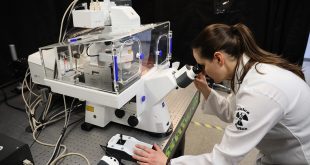Establishment of new research hubs to further strengthen Canada’s biomanufacturing and life sciences sectors
By Sean Tarry
The history of Canadian biomanufacturing and life sciences is a storied one. From the work and research of Frederick Banting and Charles Best, under the leadership of John Macleod, concerning early advancements related to the understanding of diabetes, to current labours conducted by Dr. Chil-Yong Kang and his team at the University of Western Ontario on their breakthrough Phase 2 and Phase 3 clinical trial preventive vaccine for HIV, and scores of accomplishments in between, the list of Canadian credits within the fields is lengthy. However, it’s been well established that the areas of study have lacked the appropriate funding necessary to meaningfully propel research forward. In light of this, the Government of Canada recently announced the establishment of new research hubs to accelerate Canada’s vaccine and therapeutics production, significantly strengthening the country’s biomanufacturing and life sciences sectors, in efforts to protect Canadians against any and all future health threats.
It’s an announcement of funding that’s being applauded by many within and around the biomanufacturing and life science fields, and has been hailed by some as the much-needed springboard from which the sectors can advance and grow. In fact, according to The Honourable François-Philippe Champagne, Canada’s Minister of Innovation, Science and Industry, it’s funding that could serve to provide a catalyst for continuous expansion and progress within the areas well into the future.
“To continue to protect Canadians and to build a resilient biomanufacturing ecosystem, our government is taking every action possible to be equipped with the best tools,” he says. “We’re proud to foster the research needed to produce cutting-edge discoveries and products in our very own labs that will help us build a stronger, more robust life sciences sector that responds to the needs of Canadians for decades to come.”
It’s funding that no doubt has been facilitated by impacts of the COVID-19 global pandemic and the disruptions, disturbances and devastation that it caused throughout the world. And it’s funding that’s been injected directly into pointed efforts to scale up domestic biomanufacturing capacity, which has been on the decline in the country over the course of the past half-century or so. It’s representative of a commitment by the federal government to rebuild a strong and competitive biomanufacturing and life sciences sector by strengthening the ecosystem’s foundations via the research and talent of Canada’s postsecondary institutions and hospitals, and by fostering increased collaboration with innovative companies.
The rebuild is of critical importance, says The Honourable Jean-Yves Duclos, Canada’s Minister of Health, who adds that the investment ensures that the country’s health researchers and practitioners are equipped with the resources necessary to deliver positive results.
“The health and safety of everyone in Canada is a top priority for our government,” he asserts. “To modernize and advance work in the areas of vaccines and therapeutics, we must continue to invest in health research—that is what these hubs will help us achieve. Together, with experts, provinces and territories, and other partners, we will keep strengthening our preparedness for possible future pandemics.”
In order to create the infrastructure necessary to accelerate vaccine and therapeutics production, the Government of Canada is investing $10 million in the creation of the following 5 research hubs:
• CBRF PRAIRIE Hub, led by the University of Alberta
• Canada’s Immuno-Engineering and Biomanufacturing Hub, led by The University of British Columbia
• Eastern Canada Pandemic Preparedness Hub, led by the Université de Montréal
• Canadian Pandemic Preparedness Hub, led by the University of Ottawa and McMaster University
• Canadian Hub for Health Intelligence & Innovation in Infectious Diseases, led by the University of Toronto
As part of Stage 1 of the integrated Canada Biomedical Research Fund (CBRF) and Biosciences Research Infrastructure Fund (BRIF) competition, investments are a significant portion of the focused effort being placed on bolstering research and talent development efforts within the country which will be led by institutions, working in close collaboration with their partners. Combining the acumen of academia, industry and the public and non-profit sectors, says Ted Hewitt, Chair, Tri-agency Institutional Programs Secretariat; President, Social Sciences and Humanities Research Council of Canada; Chair, Canada Research Coordinating Committee, the hubs will serve to improve Canada’s pandemic readiness and the overall health and wellbeing of Canadians.
“The Canada Biomedical Research Fund highlights the importance of multidisciplinary research in addressing critical challenges of importance to the wellbeing and prosperity of Canadians,” he points out. “The research hubs announced today are critical in our national quest to establish a strong Canadian presence in the bioindustry sector and, particularly, domestic vaccine production. We congratulate the leadership of these important research hubs, and look forward to working with them as they work to realize Canada’s full potential as a global leader in biomedical innovation.”
The multidisciplinary research that Hewitt refers to will be bountifully evident within the operations of the hubs, serving to accelerate development of advanced vaccines and therapeutics and diagnostics, while also going a long way toward supporting the vital training necessary to foster the next generation of skilled talent. In addition, the hubs are also going to serve to accelerate the development of cutting-edge research into commercially viable products and processes.
It’s all part of the government’s CBRF-BRIF strategy, which has thus far included the following investments made toward the growth of Canada’s life sciences firms:
Canada Biomedical Research Fund
$250 million to create a program to support high-risk, applied research, training and talent development partnership projects. Administered by the Social Sciences and Humanities Research Council of Canada (SSHRC) on behalf of the three federal research funding agencies: SSHRC, the Canadian Institutes of Health Research (CIHR) and the Natural Sciences and Engineering Research Council of Canada (NSERC).
Biosciences Research Infrastructure Fund
An investment of $500 million to support the biosciences infrastructure needs of postsecondary institutions and affiliated research hospitals. This fund is administered by the Canada Foundation for Innovation.
In addition, over the course of the past 2 years, the federal government has committed to investing a further $1.8 billion toward 33 different projects within biomanufacturing, vaccines and therapeutics.
All told, the investments and commitment made by the government has helped to quickly develop a framework on which the future of Canada’s biomanufacturing and life sciences sectors will be built. Reenforcing a robust ecosystem of multidisciplinary research and collaboration, the strategy, says Roseann O’Reilly Runte, President and CEO, Canada Foundation for Innovation, will contribute substantially toward protecting the country’s population against potential threats down the road, while enabling the flexibility and agility to respond swiftly and decidedly to said threats
“Collaboration enables timely and thoughtful responses to the many urgent needs caused by the global pandemic, and allows us to plan,” she explains. “Whether between research teams, across disciplines, or among institutions and industry sectors, the Biosciences Research Infrastructure Fund complements the efforts of the research hubs. The fund encourages collaboration and addresses infrastructure needs in institutions and research hospitals, to support pandemic preparedness and responses to emerging health threats.”
The hubs of biomanufacturing and life science in Canada
These research hubs—each a coalition of research unto themselves—are multidisciplinary in nature and will serve to strengthen Canada’s biomanufacturing and life sciences sectors and support critical research towards the advancement of pandemic readiness and response initiatives, including the acceleration of the production of vaccines and therapeutics.
The CBRF PRAIRIE Hub
Protecting Canada by Building on Excellence in Pandemic Preparedness. Led by the University of Alberta to accelerate the development and commercialization of vaccine, antiviral and diagnostic countermeasures for potential pandemic pathogens.
Canada’s Immuno-Engineering and Biomanufacturing Hub
Engineering Immunity for Pandemic Response. Led by The University of British Columbia to help develop next-generation immune-based therapeutics that can be manufactured domestically using the latest innovations in biomanufacturing in response to pandemics.
Eastern Canada Pandemic Preparedness Hub (ECaPPH)
Led by the Université de Montréal to increase the agility, connectivity and growth of the biomanufacturing and life sciences sectors to ensure that Canada is prepared for future pandemics and public health crises.
Canadian Pandemic Preparedness Hub (CP2H)
Led by the University of Ottawa and McMaster University to facilitate research and biomanufacturing innovations to help Canada produce vaccines, therapeutics and diagnostics ahead of future pandemics.
Canadian Hub for Health Intelligence & Innovation in Infectious Diseases (HI3)
Led by the University of Toronto to advance the concept of “personalized and precise medicine” to influence the development of vaccines, therapeutics and other public health interventions.
 BioLab Business Magazine Together, we reach farther into the Canadian Science community
BioLab Business Magazine Together, we reach farther into the Canadian Science community





